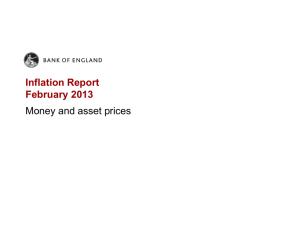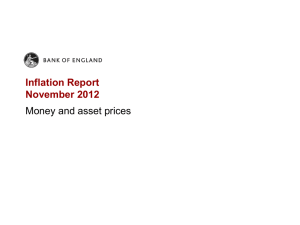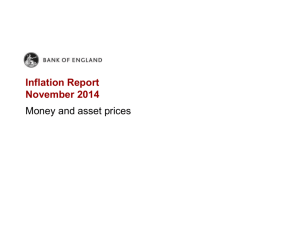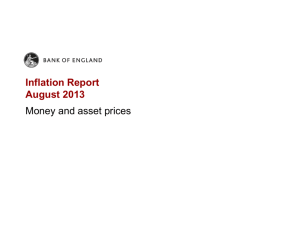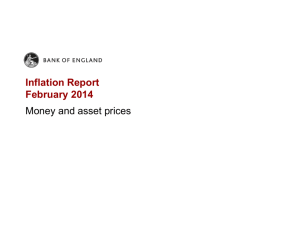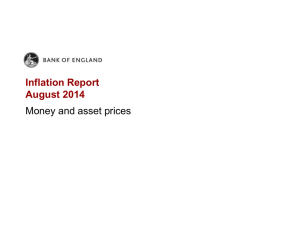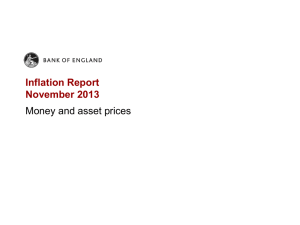Inflation Report May 2013 Money and asset prices
advertisement
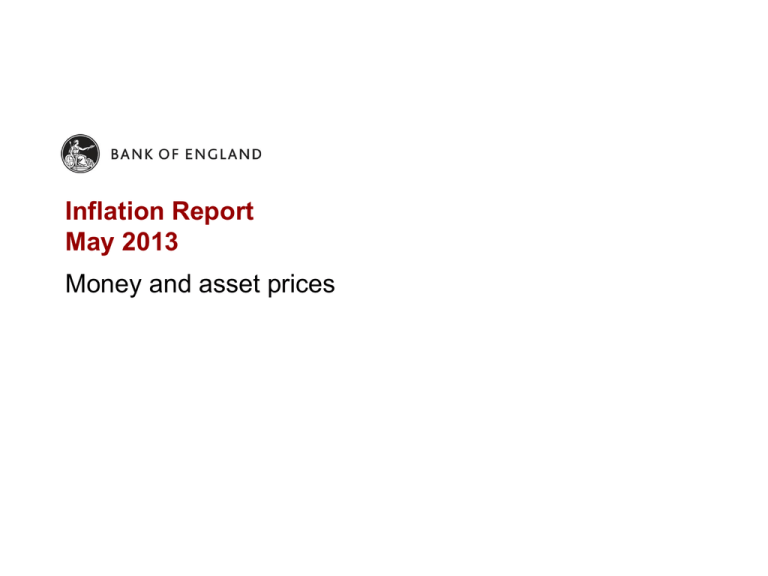
Inflation Report May 2013 Money and asset prices Chart 1.1 Bank Rate and forward market interest rates(a) Sources: Bank of England and Bloomberg. (a) The February 2013 and May 2013 curves are estimated using overnight index swap rates in the fifteen working days to 6 February 2013 and 8 May 2013 respectively. Chart 1.2 Sterling exchange rates Chart 1.3 Selected ten-year government bond yields(a) Source: Bloomberg. (a) Yields to maturity on ten-year benchmark government bonds. Chart 1.4 Five-year nominal and real gilt yields, five years forward(a) Sources: Bloomberg and Bank calculations. (a) Zero-coupon yield. Derived from the Bank’s government liability curves. Chart 1.5 International equity prices(a) Source: Thomson Reuters Datastream. (a) In local currency terms. Chart 1.6 Loans to PNFCs and households (a) M4 loans excluding the effects of securitisations and loan transfers. (b) Sterling loans by UK-resident monetary financial institutions (MFIs) and related specialist mortgage lenders excluding the effects of securitisations and loan transfers. Funding for Lending Scheme measure. Non seasonally adjusted. (c) Sterling loans by UK-resident MFIs and other lenders. Excludes student loans. Chart 1.7 UK banks’ indicative longer-term funding spreads Sources: Bank of England, Bloomberg, Markit Group Limited and Bank calculations. (a) Constant-maturity unweighted average of secondary market spreads to mid-swaps for the major UK lenders’ five-year euro senior unsecured bonds, where available. Where a five-year bond is unavailable, a proxy has been constructed based on the nearest maturity of bond available for a given institution and the historical relationship of that bond with the corresponding five-year bond. (b) Unweighted average of the five-year senior CDS premia for the major UK lenders, which provides an indicator of the spread on euro-denominated long-term wholesale bonds. (c) Sterling only. Spread over the relevant swap rate. The three-year retail bond rate is a weighted average of rates from banks and building societies within the Bank of England’s quoted rates sample. (d) The data show an unweighted average of the spread between euro-denominated covered bonds and equivalent-maturity swap rates for a selected bond issued by each of the major UK lenders. The selected bonds have residual maturities of between three and seven years. (e) Shaded area represents the gap between the minimum FLS fee of 25 basis points for a non-deleveraging Scheme participant and the maximum fee of 150 basis points for a Scheme member deleveraging by more than 5%, plus four-year overnight index swap rates, as a spread over three-month Libor rates. For more detail on the overall costs of FLS funding, see Churm et al (2012), ‘The Funding for Lending Scheme’, Bank of England Quarterly Bulletin, Vol. 52, No. 4, pages 306–20. Chart 1.8 Credit Conditions Survey: changes in availability of credit and spreads on corporate loans(a) (a) Weighted responses of lenders. A positive (negative) balance indicates that more (less) credit was available or that spreads over reference rates had fallen (risen) over the past three months. Chart 1.9 Distribution of loan rates offered to small businesses(a) Source: FSB ‘Voice of Small Business’ Panel. (a) Interest rates that small businesses that successfully applied for bank credit reported that they were offered. Results have been re-weighted to exclude ‘unsure’ responses. For further details on survey methodology, see www.fsb.org.uk/frontpage/assets/q1%20vosb.pdf. Chart 1.10 Agents’ survey: companies’ expected use of bank credit over 2013(a) (a) The balances show the proportion of companies, weighted by turnover, indicating whether they expected their use of bank credit to increase over the coming twelve months. The survey was based on over 370 respondents and was carried out between February and March 2013. Chart 1.11 Changes in quoted mortgage rates and indicative UK bank funding costs(a) Sources: Bank of England, Bloomberg and Bank calculations. (a) Change between 30 June 2012 and 30 April 2013. (b) Two-year 75% loan to value (LTV) mortgages unless otherwise stated. (c) For fixed-rate mortgages, calculated as the sum of indicative UK bank secondary market bond spreads and the swap rate corresponding to the term of the mortgage. See footnote (a) of Chart 1.7. For floating-rate mortgages, three-month Libor is used in place of a swap rate. Chart 1.12 Contributions to twelve-month broad money growth, and time deposit interest rate (a) Growth in M4 excluding intermediate other financial corporations (OFCs). May not equal the sum of its components due to the method of calculation. (b) Monthly average of UK-resident MFIs’ new sterling household time deposit rates. The Bank’s effective interest rate series are compiled using data from 24 UK MFIs. Non seasonally adjusted. Tables Table 1.A PNFCs’ net external finance raised(a) (a) (b) (c) (d) Includes sterling and foreign currency funds. Non seasonally adjusted. Includes stand-alone and programme bonds. As component series are not all seasonally adjusted, the total may not equal the sum of its components. Table 1.B Gross and net lending to UK non-financial businesses(a) (a) Non seasonally adjusted quarterly flows of sterling and foreign currency lending from UK MFIs to non-financial businesses. Small and medium-sized enterprises (SMEs) are defined as those with an annual debit account turnover on the main business account of up to £25 million. Those with an annual debit account turnover on the main business account above £25 million are termed ‘large businesses’. Data are available from 2011 Q2. (b) Quarterly average 2011 Q2–Q4. Table 1.C Housing market indicators Sources: Bank of England, Halifax, HMRC, Nationwide and Royal Institution of Chartered Surveyors (RICS). (a) (b) (c) (d) (e) Averages of monthly data. Except for property transactions, which is an average since April 2005. Number of residential property transactions with value £40,000 or above. Loan approvals for house purchase. Ratio of sales recorded over the past three months to the level of stock on estate agents’ books at the end of the month. Bank of Japan monetary stimulus Table 1 Movements in asset prices following the Bank of Japan’s policy announcement Sources: Bloomberg and Thomson Reuters Datastream. (a) The Bank of Japan made its policy announcement before UK markets opened on 4 April. Based on change in prices from 5 pm British Summer Time on 3 April 2013. Changes to May Inflation Report are based on a fifteen working day average ending on 8 May 2013. The extended Funding for Lending Scheme Table 1 Monitoring developments in credit conditions Macroprudential policy and credit conditions Figure A Selected impact channels of macroprudential capital policy and credit conditions
